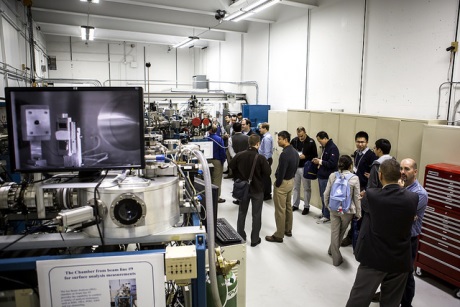A $3 million upgrade of the Michigan Ion Beam Laboratory (MIBL) will enable tests on radiation damage in materials to be performed much quicker than previously possible. Such tests will help in the life extension of existing reactors and in the development of advanced reactor designs.
 |
| Visitors at an MIBL open day on 26 October to mark the facility's upgrade (Image: Joseph Xu, Michigan Engineering Communications & Marketing) |
Irradiating materials in research reactors to study their resistance to radiation damage can take decades, the University of Michigan said. Analysis of those irradiated materials can then take several years. An upgrade of the MIBL can speed up the process so that the radiation part takes about a day and analysis can be done in just a few weeks, it said.
Until now, the laboratory could only aim a single beam at the target material. However, with the addition of a third accelerator and the ability to steer all three beams at one target, it can now produce the full range of radiation damage seen in reactors.
Reactor damage is mostly of two types: the displacement of atoms caused by the barrage of neutrons from the core, and hydrogen and helium gases that build up when nuclear reactions occur inside the material, the university said. These forms of damage are simulated with three beams that shoot ions, or charged particles, into the test material. Hydrogen and helium beams mimic the gas build-up while the third beam mimics the damage without changing the material chemistry.
Ronald Gilgenbach, chair of the department of nuclear engineering and radiological sciences at the University of Michigan, said: "The new triple-beam capabilities of the Michigan Ion Beam Laboratory make this a world-class facility for studying radiation damage in materials. The experiments carried out at MIBL are critical for life extension of existing nuclear reactors and designing new generations of reactors."
Oak Ridge National Laboratory (ORNL) director of material science and technology Jeremy Busby noted, "The ability to do triple beam irradiations is something that has not been possible since ORNL shut down its facility nearly 15 years ago." He added, "It's great to see this capability recaptured in the US as it allows for new experiments in alloy development, studies for fusion research and new forms of material characterization."
"Ion irradiations, such as those being performed at the improved University of Michigan Laboratory, may provide a cheaper and faster scientific pathway for the qualification of materials needed for advanced nuclear systems over traditional methods," said John Kelly, deputy assistant secretary for nuclear reactor technologies at the US Department of Energy (DOE).
The upgrade of the MIBL was made possible as part of a $5 million grant from the DOE for studying radiation damage and further DOE support through ORNL. The project also received funding from TerraPower, the Electric Power Research Institute, the College of Engineering and the Department of Nuclear Engineering and Radiological Sciences.
Washington-based TerraPower is developing the travelling wave reactor (TWR) - a liquid sodium-cooled fast reactor that uses depleted or natural uranium as fuel. It is designed to operate for 60 years without refuelling.
Micah Hackett, manager of materials development at TerraPower, said; "TerraPower's material program relies on University of Michigan's ion irradiation testing to rapidly test the performance of steel alloys and explore more advanced materials."
Researched and written
by World Nuclear News




_91467.jpg)
_47120.jpg)

_23621.jpg)





